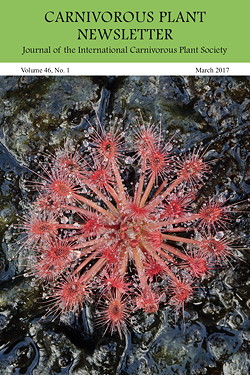International Carnivorous Plant Society
Carnivorous Plant Newsletter Archive
Unexpected discovery of 7-Methyljuglone (Ramentaceone) in several Australian sundews
Jan Schlauer and Siegfried R. H. Hartmeyer and Irmgard Hartmeyer
Carniv. Pl. Newslett. 46(1):20-22
Published 24 February 2017
https://doi.org/10.55360/cpn461.js140
Abstract
Naphthoquinones are characteristic constituents that have been detected in numerous plant families. There are at least four fundamentally different biosynthetic routes that lead to the naphthoquinone skeleton. Some naphthoquinones are formed via the acetatepolymalonate (= polyketide) pathway, and plant families notoriously known for containing such acetogenins are Iridaceae, Ebenaceae, Plumbaginaceae, Droseraceae, Nepenthaceae, Drosophyllaceae, Dioncophyllaceae, and Ancistrocladaceae. While all these families include species that form plumbagin (= 2-methyljuglone), its regioisomer 7-methyljuglone (= ramentaceone) has so far only been detected in Ebenaceae, Nepenthaceae, and Droseraceae.
Keywords: Metabolism, phytochemistry, naphthoquinones, Drosera, chemotaxonomy
Article Citation
Jan Schlauer and Siegfried R. H. Hartmeyer and Irmgard Hartmeyer. 2017. Unexpected discovery of 7-Methyljuglone (Ramentaceone) in several Australian sundews. Carniv. Pl. Newslett. 46(1):20-22. https://doi.org/10.55360/cpn461.js140
Page views: 1026
©2025 International Carnivorous Plant Society
www.carnivorousplants.org
This page is maintained by John Brittnacher.
Please contact us at our membership website, icps.clubexpress.com.
Privacy: The Carnivorous Plant Newsletter Archive website does not track users.

